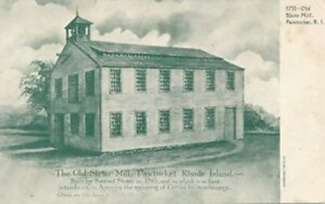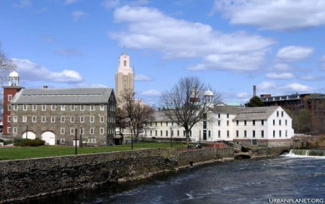Rhode Island’s History in Brownfields


As the birthplace of the American Industrial Revolution, communities in Rhode Island have served as vital locations for industries to settle given their proximity to the Blackstone River. Since the establishment of America’s first successful water powered cotton-spinning mill in 1790 (the Slater Mill in Pawtucket), the Blackstone and its surrounding communities have felt the impacts of industrial pollution. Textile manufacturers discharged dyes; leather and metal working plants discharged heavy metals; and woodworking companies discharged varnish, solvents, and paints. The river powered the factories and served as a repository for the waste they and the valley’s growing population produced.
Originally, most jobs were filled by local farm families. The early 1800s brought an influx of immigrants from England and Scotland. By the 1820s and 1830s, Irish laborers arrived to work in the mills and during the 1860s and 1870s, French-Canadians were recruited to work in the mills. With the spur of textile mills along the Blackstone, artisans and merchants opened shops, schools and churches were established, and cottages were constructed with the mills functioning as the community’s center. Populations skyrocketed between the mid-1800s and the early 1900s.
However, between 1920 and 1980, most of the Blackstone's cotton mills closed and 90% of woolen and worsted mills shut down as manufacturing in the Northeast weakened, slowing immigration rates to a trickle. Sites once used for industrial, manufacturing, or commercial uses, were abandoned or underutilized due to known or suspected contamination from past uses. Unknown liabilities have prevented communities, developers, and investors from restoring these properties to productive use and revitalizing impacted neighborhoods.
For over 200 years, industries have polluted the soils and groundwater with a plethora of hazardous materials and/or petroleum products threatening all of Rhode Island's communities. Left unaddressed, brownfields drain surrounding areas of their vitality, exacerbating neighborhood blight and economic stagnation. Environmental contamination poses health threats, and abandoned buildings encourage vandalism and illegal dumping. These properties also become a fiscal drain for municipalities, reducing their ability to provide public services and contain local property taxes. Through the investigation and remediation of brownfields, Rhode Island has made progress in mitigating these impacts and restoring properties to viable and productive uses that benefit the surrounding communities.
Addressing RI Brownfields
The Site Remediation Program
In 1995, Rhode Island passed the Industry Property Remediation and Reuse Act (amended in 1997) and established a voluntary program for brownfields cleanup through DEM. The program encourages and supports the redevelopment and reuse of contaminated properties. The goal of the program is to provide fair, comprehensive, and consistent parameters for the investigation and remediation of hazardous waste, hazardous material, and petroleum releases, implemented in a timely and cost-effective manner.
Targeted Brownfield Assessments (TBAs)
Targeted Brownfield Assessments (TBAs) are conducted via the Site Remediation Program's proactive TBA Program. The TBA Program uses funding awarded by the U.S. EPA through a competitive process to assist municipalities and non-profit organizations in assessing known or potentially contaminated properties.
In 1994, RI was awarded its first EPA grant for the assessment of brownfields. From 1994 to 2022, the State of RI has received a total of $46,217,189 in EPA funding for assessment, cleanup, and job training, which has led to many revitalized brownfield sites and successes throughout all of RI. Continued application for funding from EPA allows RIDEM to maintain and advances successes in brownfields' investigation and remediation, and spur redevelopment.
